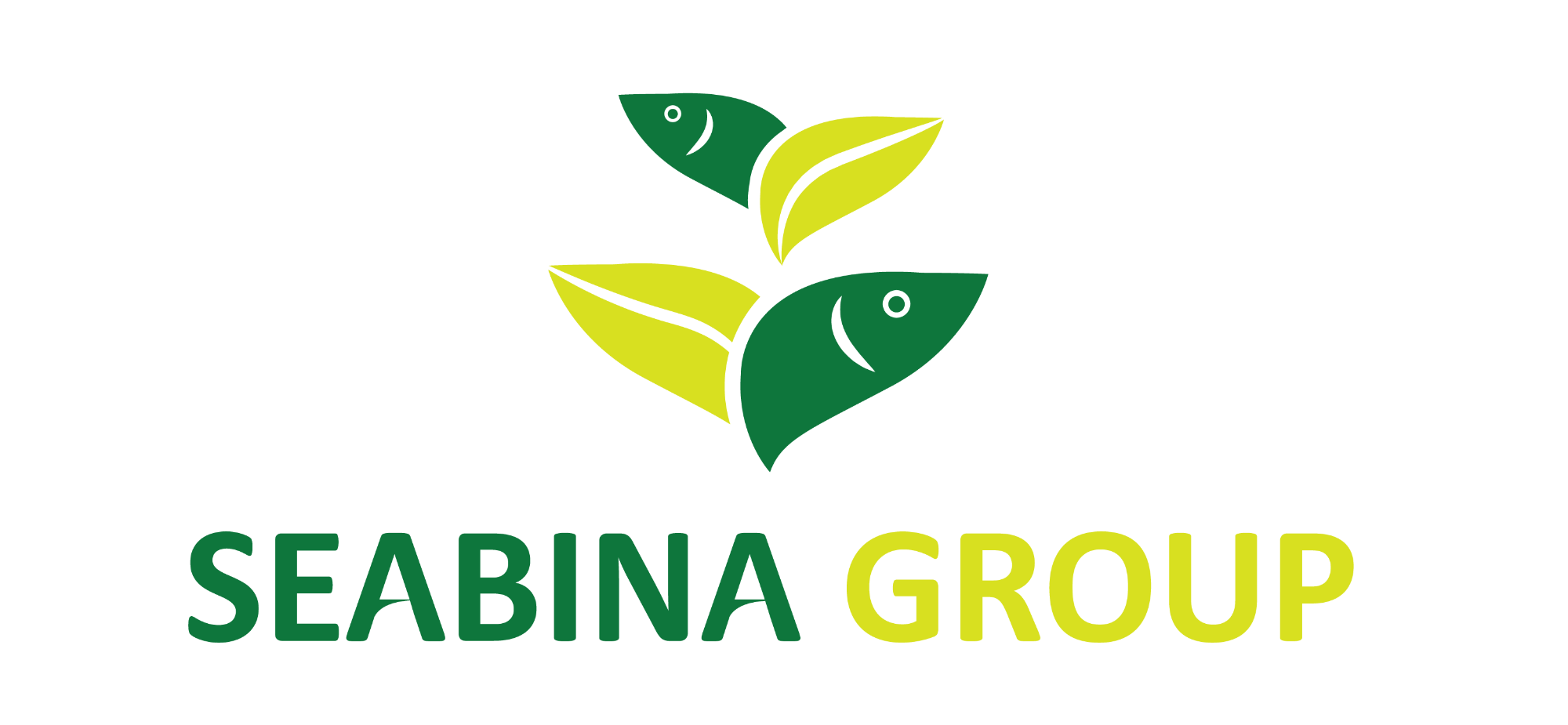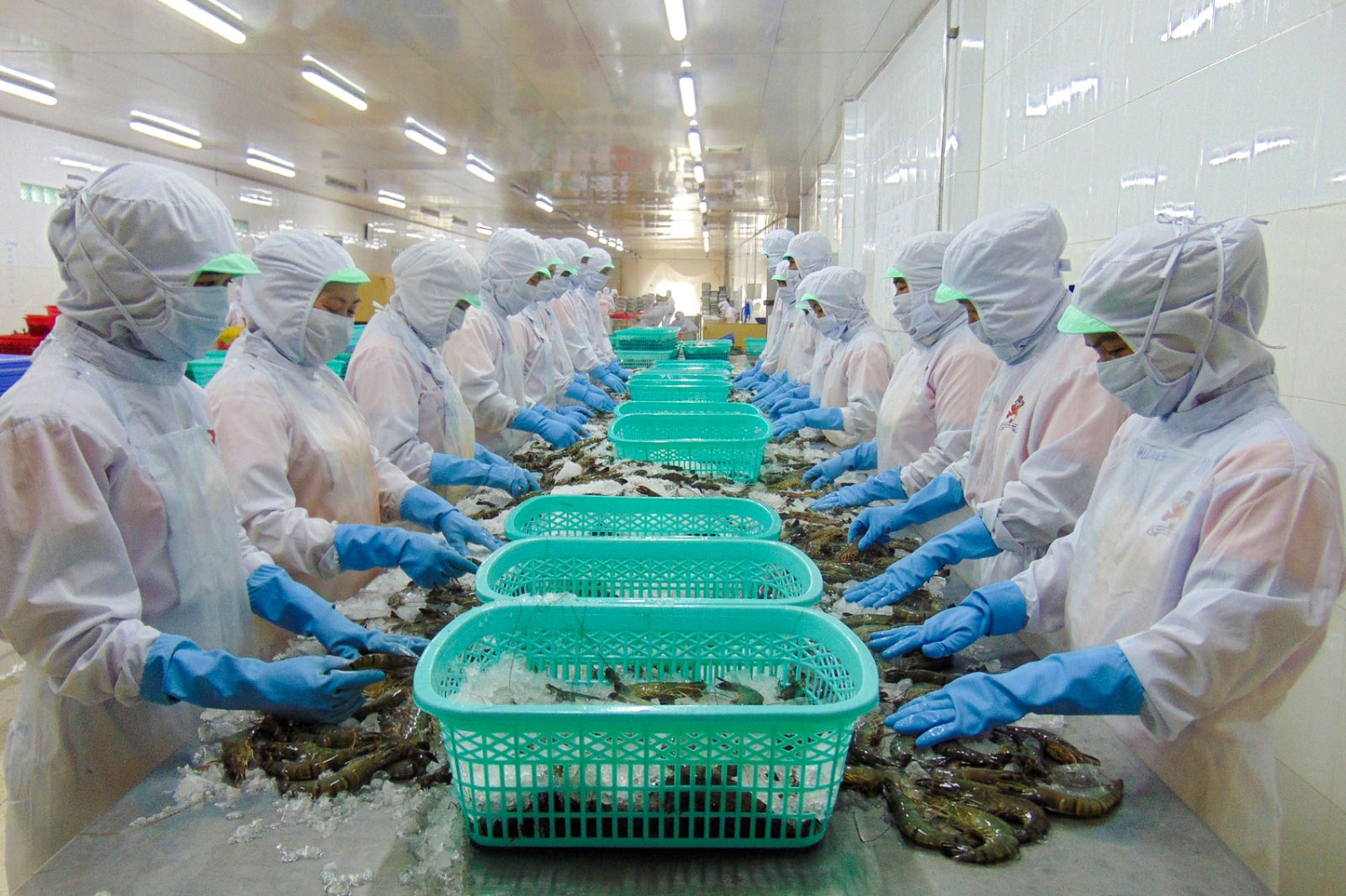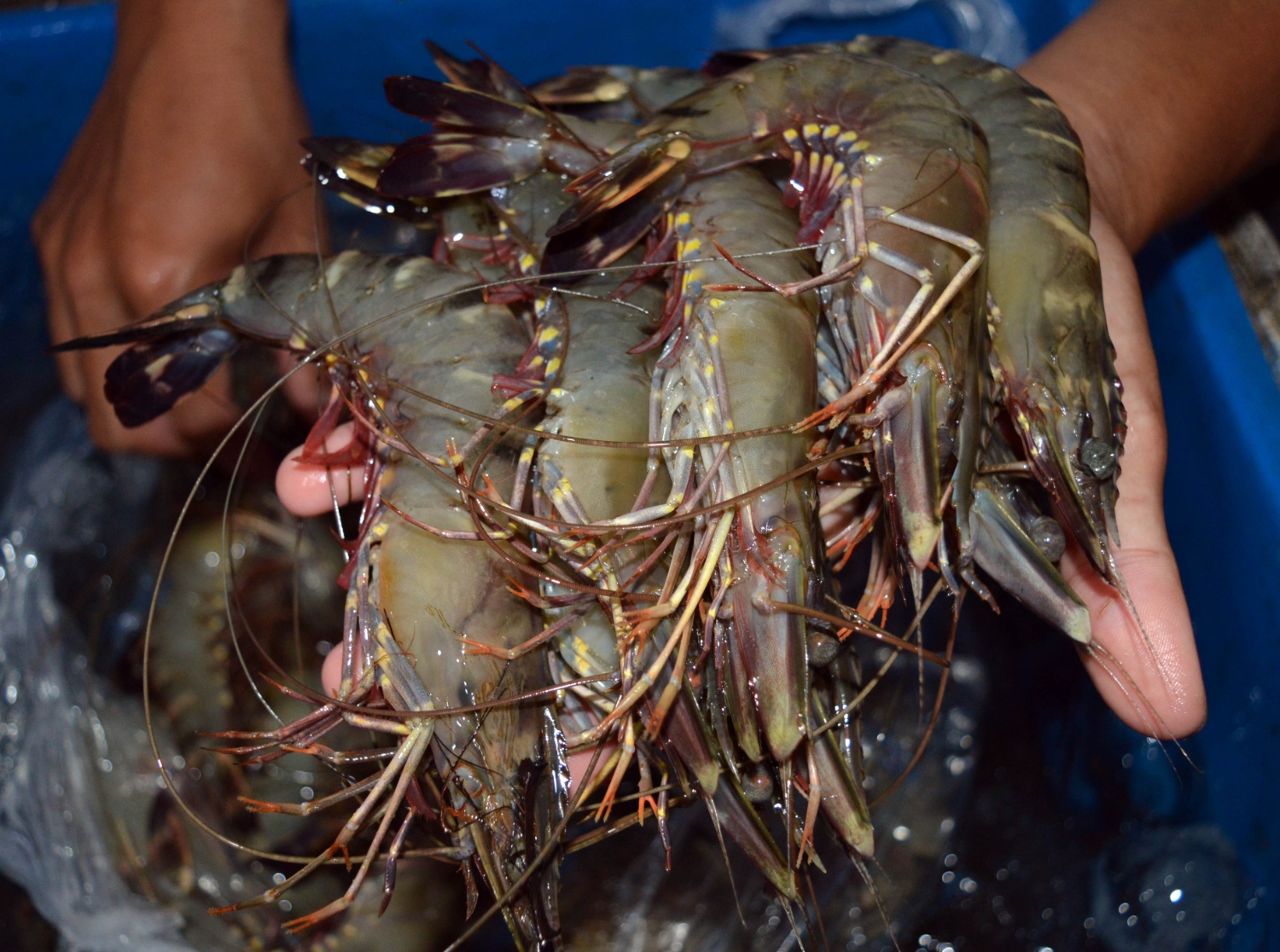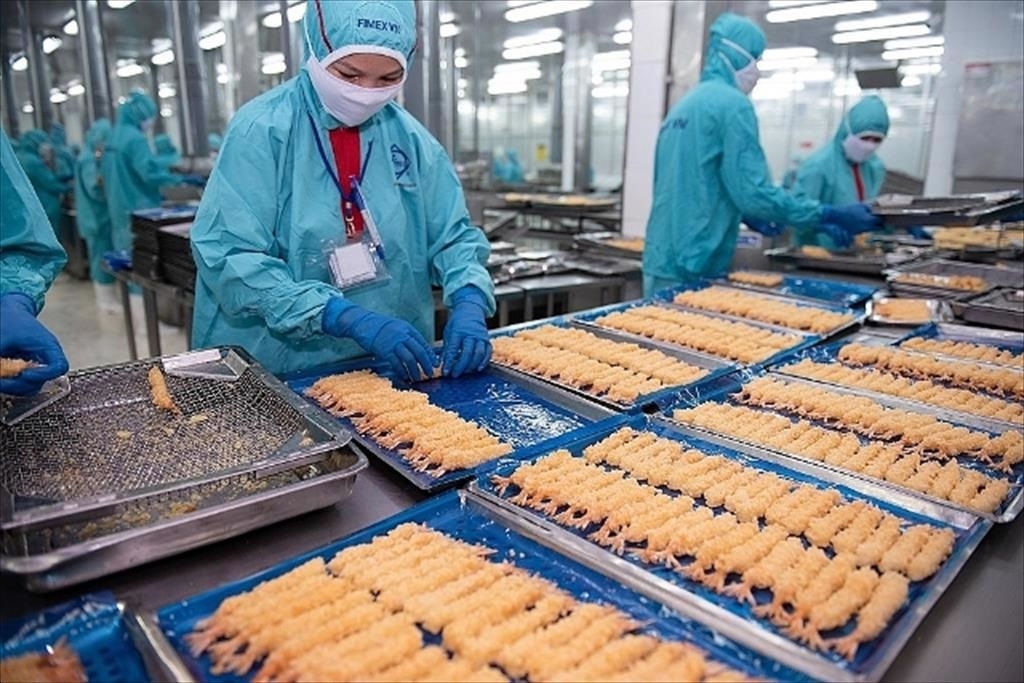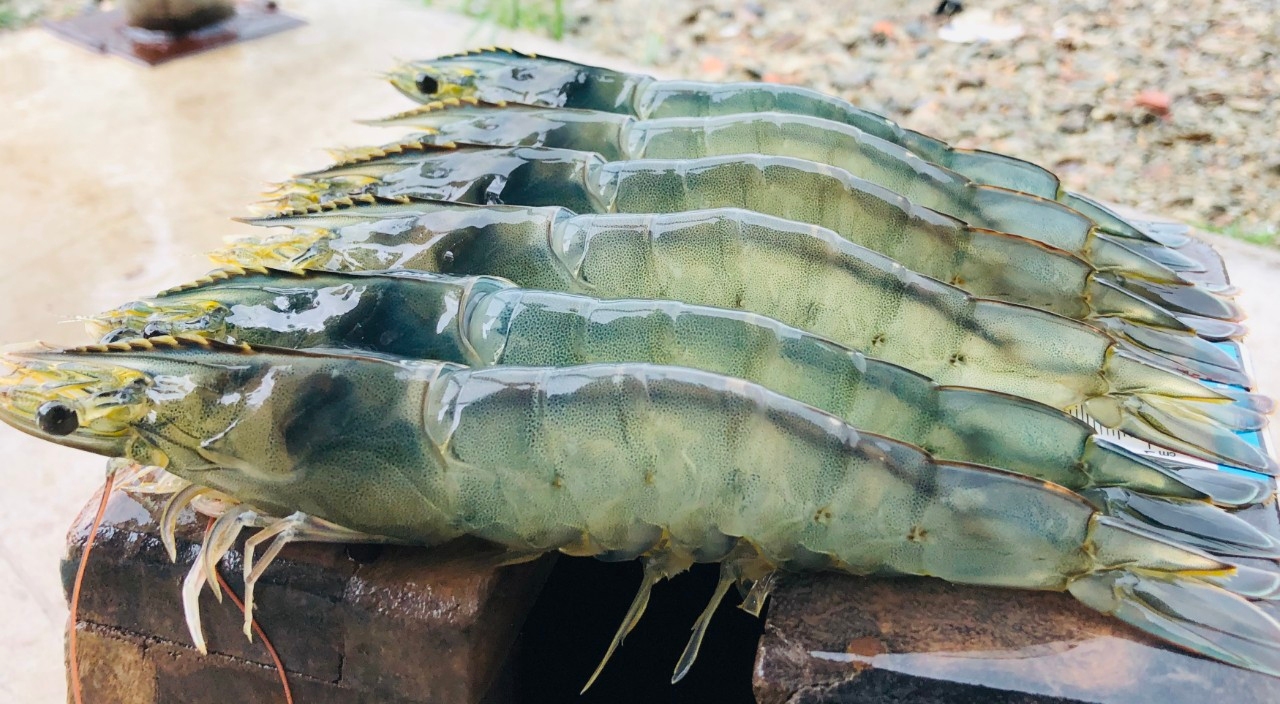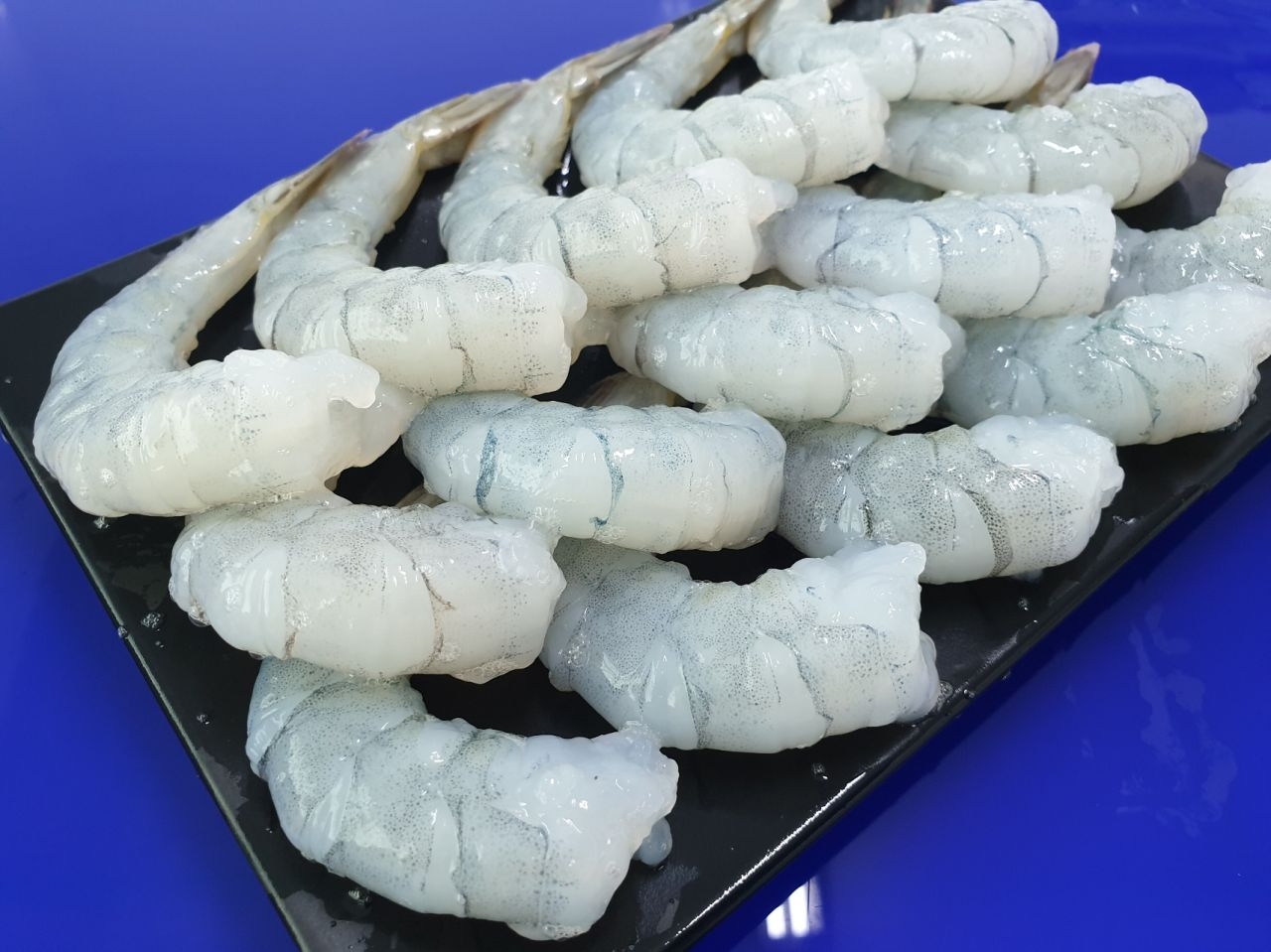
Delta variant, freights and aqua feeds escalate: 3 dumbbells at the same time weigh on the seafood industry
Delta variant, freights and aqua feeds escalate: 3 dumbbells at the same time weigh on the seafood industry
Seafood businesses continue to face risks. Freights are still anchored at a high level, although prices of animal feeds have decreased, they are still increasing by 20% over the same period. In addition, the Delta variant is complicated, causing the production activities of enterprises to decline.

Fresh black tiger shrimp, Photo: SEABINA GROUP
The capacity of seafood factories is only 30-40% because of the new wave of COVID-19
Vietnam's seafood industry is experiencing significant disruption in production due to the impact of the COVID-19 epidemic.
The Ministry of Agriculture and Rural Development said that according to the plan, the seafood industry aims to export $8.7 to 9 billion for the whole year.
However, due to the complicated situation of the COVID-19 epidemic, seafood companies, especially in the Southern region (accounting for 65% of seafood exports) are in a very difficult situation.
Seafood production and export decreased significantly from the second half of July, down about 15-20% compared to June. It is estimated that the capacity of seafood processing factories in the whole region is only about 30-40%.
Total seafood export turnover in the first half of 2021 reached 4.1 billion USD, up nearly 15% over the same period last year and equivalent to about 45% of the whole year plan.
In a worse situation, the disease continues to persist and China strengthens control of frozen seafood imported from ASEAN, including Vietnam, seafood exports can only reach a maximum of about 8.8 billion USD.
The situation of seafood production in the last months of the year is highly dependent on the operation of seafood processing factories.
Currently, seafood processing enterprises try to maintain production and organize "3 on-site". However, there are still quite many seafood processing factories that do not meet the conditions because the costs are too great in ensuring disease safety, leading to the shutdown.
In an interview with UnderCurrent News , a seafood business said food prices doubled.
For some factories, they could not bear the cost of food for all employees and were forced to close.
In addition, truck drivers are required to be tested for COVID-19 every 3 days, causing delays in transport operations and causing driver shortages. Every day businesses are faced with the dilemma of what to sacrifice and what to prioritize.
“On July 22, there was an online supply contract auction for Walmart. However, our company cannot bid because we can't be sure what might happen in the coming months," he said.
According to the Bank for Investment and Development of Vietnam Securities Joint Stock Company (BSC), the social distancing in the southern provinces in the second quarter is the main risk and may negatively affect the business activities of seafood enterprises.
Accordingly, labor productivity decreases when the distance is required (dividing work shifts, minimizing the number of employees, ..) and increasing costs for businesses (costs of conducting 3 on-site activities, costs of quarantine, etc...).
In a recent report, Sao Ta Food Joint Stock Company said that the processing workshops of the central factory have over 2,000 employees, now there are 500. The company has planned to reduce the operation of 3 workshops, maintaining 2 workshops. At the same time, the work must be reassigned to the workers in the factories.
However, the company still had to continuously adjust operations due to shortage of supplies and high prices. Thousands of employees of the company are still unemployed, without timely support.
On the other hand, for shrimp farmers, due to the spread of the crop, they do not harvest well and put pressure on the processing plant. As a result, shrimp prices fell in the first few days, and then recovered. Sao Ta said that the company has enough materials to process every day, partly because the processing capacity is only 30-40% compared to normal days.
According to the financial report of the second quarter of 2021 of Vinh Hoan Joint Stock Company (Code: VHC), in the face of difficulties of the epidemic, Vinh Hoan's cost of goods sold recorded a higher increase than the increase in net revenue, making gross profit margin reduced from 20% to 18.5%.
At the same time, most of the operating expenses increased over the same period, Vinh Hoan also recorded a profit of 261 billion VND, up 17% over the same period last year.
Businesses are impatient because of "heavenly" sea freight
In addition to the 4th wave of COVID-19, the rising freights and the shortage of containers are also a pincer that has strangled seafood businesses in recent times.
Talking to the writer, Mr. Nguyen Hoai Nam - Deputy General Secretary of the Association of Seafood Exporters and Producers (VASEP) said that although the export contracts are in the form of FOB but customers only bear a part of the shipping fees instead of 100% as usual because freights increased too highly, sometimes many times higher than normal.
Typically, the shipping price of refrigerated containers from Vietnam to the port of Los Angeles (USA) in early 2020 is 1,800 USD/container, increasing about 4 times to 8,000 USD/USD in just 5 months.
In the same period, the freight rate for transporting refrigerated containers from Vietnam to the port of Southampton (UK) also increased 6 times to 9,100 USD/container.
The freights are so high, but booking containers has also become more difficult than ever because of the shortage of empty containers that has lasted from the end of 2020 until now.
As reflected by businesses, if you want to rent a container, you have to book a month in advance, but in many cases, you still can't rent it. Businesses are almost competing together to rent containers.
VASEP reflects in the current empty container market, the company that pays the higher freight, the shipping company will issue the container.
Even businesses have successfully booked containers, but due to the daily increase in rental fees, shipping lines are willing to cancel the booking of that business to transfer to another business if the price is higher.
The situation was exacerbated by the blockage of the Suez Canal in late March and congestion at seaports.
At the 2021 Annual General Meeting of Shareholders held in June, Mr. Le Van Quang, General Director of Minh Phu Seafood Corporation (Code: MPC) said that the situation of freights is difficult to predict.
“Currently, the lack of containers is very serious. Meanwhile, the Chinese side is trying to pull all the containers towards them.
Container prices increased a lot, freights increased 2-4 times compared to normal, but we also don't know if the freights will increase again and if there are containers to export," Mr. Quang concerned.
Mr. Quang said that the rapid increase in freights and container rental costs will be a big risk to Minh Phu's shrimp selling price because this cost fluctuates continuously and strongly due to lack of supply, making it difficult for the company to plan in the selling prices.
Minh Phu's profit after tax in the first quarter recorded a decrease of 51% compared to the same period last year to 27 billion VND.
Quang said that in 2021, Minh Phu may only reach 80% of this year's profit target.
"The production plan will be achieved, but the sale plan and profit plan will decrease by 20%. If we can solve the container problem, we will achieve or even exceed. The production situation is good. Last May, exports increased by 46% in volume and value by nearly 60%, "said Mr. Quang.
Prices of aqua feeds skyrocketed
The increase in the price of aqua feeds also contributes to the increased costs of enterprises. There was a time when the price of animal feed increased by 30-40%.
Responding to Industry and Trade Newspaper , Mr. Tran Dinh Luan, Director of the General Department of Fisheries, said that in the cost structure of seafood production, food accounts for about 50-70%, with an average of 60%.
Therefore, when the price fluctuates, it will very quickly affect the market, increasing production costs, increasing risks for the seafood sector, especially reducing the competitiveness of seafood products.
Transportation charges and anchor material costs at high prices are expected to continue to negatively affect in the third quarter of 2021.
BSC believes that seafood businesses continue to face risks. Freight s are still anchored at a high level, although prices of animal feeds have decreased, they are still increasing by 20% over the same period.
This will negatively affect input costs as feed costs account for about 60% - 70% of aquaculture costs.
According to the Vietnam Association of Seafood Exporters and Producers (VASEP), although the export market is quite favorable, the growth of seafood exports at the end of the year depends a lot on the timing and ability to control the COVID-19 epidemic.
Under the best conditions, when the market calms down and the disease is under control after 3 months, the monthly increase in seafood exports will be about 6-8%. At that time, seafood export in 2021 can reach the target of 9 billion USD.
Source: vietnambiz.vn, SEABINA GROUP's translation
Readers' opinions
Other news
- Early stocking to get good price 21/12/2024
- Shrimp prices rise again in Vietnam, and reach 12-month high in India 28/08/2024
- Vietnamese Shrimp Industry Faces Many Challenges: Farmers Prefer Quality but Cheap Shrimp Seeds 01/08/2024
- Raw shrimp prices fall: Another challenge the shrimp industry must overcome 03/07/2024
- Storms in the shrimp industry may last in 2024 07/05/2024
- Vietnam's Seafood Exports Reach $2 Billion In Q1 03/04/2024
- King of shrimp industry profits in 2023 02/04/2024
- A difficult story for shrimp 11/03/2024
- Shrimp exports face a difficult problem 23/02/2023
- Vietnam’s shrimp exports reached 141 million USD in the first month of 2023 22/02/2023
Vietnam's seafood industry is experiencing significant disruption in production due to the impact of the COVID-19 epidemic.
The Ministry of Agriculture and Rural Development said that according to the plan, the seafood industry aims to export $8.7 to 9 billion for the whole year.
However, due to the complicated situation of the COVID-19 epidemic, seafood companies, especially in the Southern region (accounting for 65% of seafood exports) are in a very difficult situation.
Seafood production and export decreased significantly from the second half of July, down about 15-20% compared to June. It is estimated that the capacity of seafood processing factories in the whole region is only about 30-40%.
Total seafood export turnover in the first half of 2021 reached 4.1 billion USD, up nearly 15% over the same period last year and equivalent to about 45% of the whole year plan.
In a worse situation, the disease continues to persist and China strengthens control of frozen seafood imported from ASEAN, including Vietnam, seafood exports can only reach a maximum of about 8.8 billion USD.
The situation of seafood production in the last months of the year is highly dependent on the operation of seafood processing factories.
Currently, seafood processing enterprises try to maintain production and organize "3 on-site". However, there are still quite many seafood processing factories that do not meet the conditions because the costs are too great in ensuring disease safety, leading to the shutdown.
In an interview with UnderCurrent News , a seafood business said food prices doubled.
For some factories, they could not bear the cost of food for all employees and were forced to close.
In addition, truck drivers are required to be tested for COVID-19 every 3 days, causing delays in transport operations and causing driver shortages. Every day businesses are faced with the dilemma of what to sacrifice and what to prioritize.
“On July 22, there was an online supply contract auction for Walmart. However, our company cannot bid because we can't be sure what might happen in the coming months," he said.
According to the Bank for Investment and Development of Vietnam Securities Joint Stock Company (BSC), the social distancing in the southern provinces in the second quarter is the main risk and may negatively affect the business activities of seafood enterprises.
Accordingly, labor productivity decreases when the distance is required (dividing work shifts, minimizing the number of employees, ..) and increasing costs for businesses (costs of conducting 3 on-site activities, costs of quarantine, etc...).
In a recent report, Sao Ta Food Joint Stock Company said that the processing workshops of the central factory have over 2,000 employees, now there are 500. The company has planned to reduce the operation of 3 workshops, maintaining 2 workshops. At the same time, the work must be reassigned to the workers in the factories.
However, the company still had to continuously adjust operations due to shortage of supplies and high prices. Thousands of employees of the company are still unemployed, without timely support.
On the other hand, for shrimp farmers, due to the spread of the crop, they do not harvest well and put pressure on the processing plant. As a result, shrimp prices fell in the first few days, and then recovered. Sao Ta said that the company has enough materials to process every day, partly because the processing capacity is only 30-40% compared to normal days.
According to the financial report of the second quarter of 2021 of Vinh Hoan Joint Stock Company (Code: VHC), in the face of difficulties of the epidemic, Vinh Hoan's cost of goods sold recorded a higher increase than the increase in net revenue, making gross profit margin reduced from 20% to 18.5%.
At the same time, most of the operating expenses increased over the same period, Vinh Hoan also recorded a profit of 261 billion VND, up 17% over the same period last year.
Businesses are impatient because of "heavenly" sea freight
In addition to the 4th wave of COVID-19, the rising freights and the shortage of containers are also a pincer that has strangled seafood businesses in recent times.
Talking to the writer, Mr. Nguyen Hoai Nam - Deputy General Secretary of the Association of Seafood Exporters and Producers (VASEP) said that although the export contracts are in the form of FOB but customers only bear a part of the shipping fees instead of 100% as usual because freights increased too highly, sometimes many times higher than normal.
Typically, the shipping price of refrigerated containers from Vietnam to the port of Los Angeles (USA) in early 2020 is 1,800 USD/container, increasing about 4 times to 8,000 USD/USD in just 5 months.
In the same period, the freight rate for transporting refrigerated containers from Vietnam to the port of Southampton (UK) also increased 6 times to 9,100 USD/container.
The freights are so high, but booking containers has also become more difficult than ever because of the shortage of empty containers that has lasted from the end of 2020 until now.
As reflected by businesses, if you want to rent a container, you have to book a month in advance, but in many cases, you still can't rent it. Businesses are almost competing together to rent containers.
VASEP reflects in the current empty container market, the company that pays the higher freight, the shipping company will issue the container.
Even businesses have successfully booked containers, but due to the daily increase in rental fees, shipping lines are willing to cancel the booking of that business to transfer to another business if the price is higher.
The situation was exacerbated by the blockage of the Suez Canal in late March and congestion at seaports.
At the 2021 Annual General Meeting of Shareholders held in June, Mr. Le Van Quang, General Director of Minh Phu Seafood Corporation (Code: MPC) said that the situation of freights is difficult to predict.
“Currently, the lack of containers is very serious. Meanwhile, the Chinese side is trying to pull all the containers towards them.
Container prices increased a lot, freights increased 2-4 times compared to normal, but we also don't know if the freights will increase again and if there are containers to export," Mr. Quang concerned.
Mr. Quang said that the rapid increase in freights and container rental costs will be a big risk to Minh Phu's shrimp selling price because this cost fluctuates continuously and strongly due to lack of supply, making it difficult for the company to plan in the selling prices.
Minh Phu's profit after tax in the first quarter recorded a decrease of 51% compared to the same period last year to 27 billion VND.
Quang said that in 2021, Minh Phu may only reach 80% of this year's profit target.
"The production plan will be achieved, but the sale plan and profit plan will decrease by 20%. If we can solve the container problem, we will achieve or even exceed. The production situation is good. Last May, exports increased by 46% in volume and value by nearly 60%, "said Mr. Quang.
Prices of aqua feeds skyrocketed
The increase in the price of aqua feeds also contributes to the increased costs of enterprises. There was a time when the price of animal feed increased by 30-40%.
Responding to Industry and Trade Newspaper , Mr. Tran Dinh Luan, Director of the General Department of Fisheries, said that in the cost structure of seafood production, food accounts for about 50-70%, with an average of 60%.
Therefore, when the price fluctuates, it will very quickly affect the market, increasing production costs, increasing risks for the seafood sector, especially reducing the competitiveness of seafood products.
Transportation charges and anchor material costs at high prices are expected to continue to negatively affect in the third quarter of 2021.
BSC believes that seafood businesses continue to face risks. Freight s are still anchored at a high level, although prices of animal feeds have decreased, they are still increasing by 20% over the same period.
This will negatively affect input costs as feed costs account for about 60% - 70% of aquaculture costs.
According to the Vietnam Association of Seafood Exporters and Producers (VASEP), although the export market is quite favorable, the growth of seafood exports at the end of the year depends a lot on the timing and ability to control the COVID-19 epidemic.
Under the best conditions, when the market calms down and the disease is under control after 3 months, the monthly increase in seafood exports will be about 6-8%. At that time, seafood export in 2021 can reach the target of 9 billion USD.
Source: vietnambiz.vn, SEABINA GROUP's translation
Readers' opinions
Other news
- Early stocking to get good price 21/12/2024
- Shrimp prices rise again in Vietnam, and reach 12-month high in India 28/08/2024
- Vietnamese Shrimp Industry Faces Many Challenges: Farmers Prefer Quality but Cheap Shrimp Seeds 01/08/2024
- Raw shrimp prices fall: Another challenge the shrimp industry must overcome 03/07/2024
- Storms in the shrimp industry may last in 2024 07/05/2024
- Vietnam's Seafood Exports Reach $2 Billion In Q1 03/04/2024
- King of shrimp industry profits in 2023 02/04/2024
- A difficult story for shrimp 11/03/2024
- Shrimp exports face a difficult problem 23/02/2023
- Vietnam’s shrimp exports reached 141 million USD in the first month of 2023 22/02/2023
In addition to the 4th wave of COVID-19, the rising freights and the shortage of containers are also a pincer that has strangled seafood businesses in recent times.
Talking to the writer, Mr. Nguyen Hoai Nam - Deputy General Secretary of the Association of Seafood Exporters and Producers (VASEP) said that although the export contracts are in the form of FOB but customers only bear a part of the shipping fees instead of 100% as usual because freights increased too highly, sometimes many times higher than normal.
Typically, the shipping price of refrigerated containers from Vietnam to the port of Los Angeles (USA) in early 2020 is 1,800 USD/container, increasing about 4 times to 8,000 USD/USD in just 5 months.
In the same period, the freight rate for transporting refrigerated containers from Vietnam to the port of Southampton (UK) also increased 6 times to 9,100 USD/container.
The freights are so high, but booking containers has also become more difficult than ever because of the shortage of empty containers that has lasted from the end of 2020 until now.
As reflected by businesses, if you want to rent a container, you have to book a month in advance, but in many cases, you still can't rent it. Businesses are almost competing together to rent containers.
VASEP reflects in the current empty container market, the company that pays the higher freight, the shipping company will issue the container.
Even businesses have successfully booked containers, but due to the daily increase in rental fees, shipping lines are willing to cancel the booking of that business to transfer to another business if the price is higher.
The situation was exacerbated by the blockage of the Suez Canal in late March and congestion at seaports.
At the 2021 Annual General Meeting of Shareholders held in June, Mr. Le Van Quang, General Director of Minh Phu Seafood Corporation (Code: MPC) said that the situation of freights is difficult to predict.
“Currently, the lack of containers is very serious. Meanwhile, the Chinese side is trying to pull all the containers towards them.
Container prices increased a lot, freights increased 2-4 times compared to normal, but we also don't know if the freights will increase again and if there are containers to export," Mr. Quang concerned.
Mr. Quang said that the rapid increase in freights and container rental costs will be a big risk to Minh Phu's shrimp selling price because this cost fluctuates continuously and strongly due to lack of supply, making it difficult for the company to plan in the selling prices.
Minh Phu's profit after tax in the first quarter recorded a decrease of 51% compared to the same period last year to 27 billion VND.
Quang said that in 2021, Minh Phu may only reach 80% of this year's profit target.
"The production plan will be achieved, but the sale plan and profit plan will decrease by 20%. If we can solve the container problem, we will achieve or even exceed. The production situation is good. Last May, exports increased by 46% in volume and value by nearly 60%, "said Mr. Quang.
Prices of aqua feeds skyrocketed
The increase in the price of aqua feeds also contributes to the increased costs of enterprises. There was a time when the price of animal feed increased by 30-40%.
Responding to Industry and Trade Newspaper , Mr. Tran Dinh Luan, Director of the General Department of Fisheries, said that in the cost structure of seafood production, food accounts for about 50-70%, with an average of 60%.
Therefore, when the price fluctuates, it will very quickly affect the market, increasing production costs, increasing risks for the seafood sector, especially reducing the competitiveness of seafood products.
Transportation charges and anchor material costs at high prices are expected to continue to negatively affect in the third quarter of 2021.
BSC believes that seafood businesses continue to face risks. Freight s are still anchored at a high level, although prices of animal feeds have decreased, they are still increasing by 20% over the same period.
This will negatively affect input costs as feed costs account for about 60% - 70% of aquaculture costs.
According to the Vietnam Association of Seafood Exporters and Producers (VASEP), although the export market is quite favorable, the growth of seafood exports at the end of the year depends a lot on the timing and ability to control the COVID-19 epidemic.
Under the best conditions, when the market calms down and the disease is under control after 3 months, the monthly increase in seafood exports will be about 6-8%. At that time, seafood export in 2021 can reach the target of 9 billion USD.
Source: vietnambiz.vn, SEABINA GROUP's translation
Readers' opinions
The increase in the price of aqua feeds also contributes to the increased costs of enterprises. There was a time when the price of animal feed increased by 30-40%.
Responding to Industry and Trade Newspaper , Mr. Tran Dinh Luan, Director of the General Department of Fisheries, said that in the cost structure of seafood production, food accounts for about 50-70%, with an average of 60%.
Therefore, when the price fluctuates, it will very quickly affect the market, increasing production costs, increasing risks for the seafood sector, especially reducing the competitiveness of seafood products.
Transportation charges and anchor material costs at high prices are expected to continue to negatively affect in the third quarter of 2021.
BSC believes that seafood businesses continue to face risks. Freight s are still anchored at a high level, although prices of animal feeds have decreased, they are still increasing by 20% over the same period.
This will negatively affect input costs as feed costs account for about 60% - 70% of aquaculture costs.
According to the Vietnam Association of Seafood Exporters and Producers (VASEP), although the export market is quite favorable, the growth of seafood exports at the end of the year depends a lot on the timing and ability to control the COVID-19 epidemic.
Under the best conditions, when the market calms down and the disease is under control after 3 months, the monthly increase in seafood exports will be about 6-8%. At that time, seafood export in 2021 can reach the target of 9 billion USD.
Source: vietnambiz.vn, SEABINA GROUP's translation
Other news
- Early stocking to get good price 21/12/2024
- Shrimp prices rise again in Vietnam, and reach 12-month high in India 28/08/2024
- Vietnamese Shrimp Industry Faces Many Challenges: Farmers Prefer Quality but Cheap Shrimp Seeds 01/08/2024
- Raw shrimp prices fall: Another challenge the shrimp industry must overcome 03/07/2024
- Storms in the shrimp industry may last in 2024 07/05/2024
- Vietnam's Seafood Exports Reach $2 Billion In Q1 03/04/2024
- King of shrimp industry profits in 2023 02/04/2024
- A difficult story for shrimp 11/03/2024
- Shrimp exports face a difficult problem 23/02/2023
- Vietnam’s shrimp exports reached 141 million USD in the first month of 2023 22/02/2023
